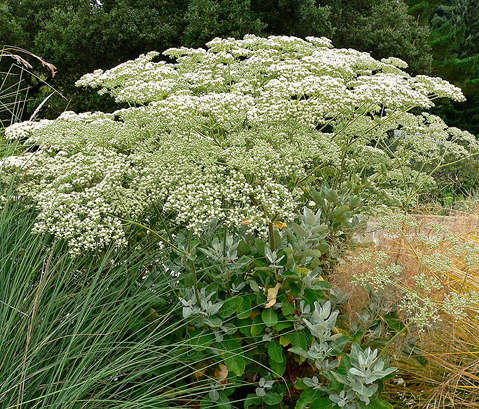Wild Buckwheat
Unsung, Overlooked, Absolutely Fantastic Additions to Any Garden.

Wild buckwheat is an unsung, overlooked, absolutely fantastic addition to any garden. No joke; members of this genus of American natives are sometimes handsome beyond words, now and then quirky enough to start a conversation, but always interesting, whether in bloom or not. They are all in the genus Eriogonum.
There are around 250 species in this varied genus (about half are native to California), but only eight or so species and selections are readily available for landscapes here. Most buckwheat native to this region has silvery-gray foliage, from downy white to downright felty. All bloom with tiny flowers clustered together in small groups that are arrayed on complex inflorescences held above the foliage on sturdy stalks. After the flowers, seedheads mature in various fall shades. As inconspicuous as these flowers sound on paper, in the aggregate, they can be stunning. To top it all off, wild buckwheat is drought tolerant and attracts beneficial insects to the garden! It can also help with erosion control on slopes. Here’s a rundown on these versatile California natives.
Santa Cruz Island buckwheat (Eriogonum arborescens) is endemic to several of the Channel Islands, where it can be wind-sheared to only a couple of feet in height. In protected sites, it may grow to six feet tall, spreading to three feet or more in diameter. Since it is more arborescent, its attractive shredding bark can also become an asset. Leaves are silvery underneath, and the multitude of flat-topped inflorescences start out with pink buds that open to a bright ivory. As the flowers age, they take on a reddish tone, and the whole shrub glows with a deep golden brown. The sturdy mature (dry) flower stalks work well in dry arrangements.
On the other end of the size spectrum are ashyleaf and saffron buckwheat. Their species names tell the tale of two different attributes: ashyleaf buckwheat (E. cinereum) has leaves that look as if they are covered in ash, while saffron buckwheat (E. crocatum) also has very pale leaves, but it is the vibrant yellow flowers that give it its name. Ashyleaf buckwheat will spread farther—to three feet across—while saffron buckwheat needs to be planted in multiples to create a big show at the front of the planting bed with its snowy foliage and the surprising, eye-popping flowers. As buds, they are a deep orange, opening to a very sunny yellow. Fabulous!
For hikers of area trails, California buckwheat (E. fasciculatum) is a familiar part of the trailside vegetation. Crossing habitat barriers with aplomb, it climbs from coastal scrub habitats to chaparral in the front country and even finds a niche in desert woodlands and desert scrub farther inland. Several named selections have been propagated from desirable forms on the coast and may surface at nurseries and plant sales. This particular buckwheat forms mounds of vegetation up to three feet in height and spreading to four feet in diameter. The leaves are among the smallest, looking much like short pine needles, resembling rosemary in many ways. The tiny flowers in multiple small heads stand above the foliage in spring and summer. As they mature, the pink-tinged ivory aspect deepens to a rusty brown. It may sound drab, but it makes a lovely autumn display.
The acknowledged star in this genus is Saint Catherine’s lace (E. giganteum). It is the biggest and the boldest. The foliage is silvery above and white below—very handsome as an accent plant in the background that can also be planted in multiples as a screen. Large, flat-topped clusters of white flowers seem to float above the plant in summer. The rich, orange-brown color that they turn in fall is equally as stunning.
Not all buckwheat flowers age so well: Red-flowered buckwheat (E. grande var. rubescens) is lovely when in bloom, but old flowers should be sheared off when they are done. The gray-green foliage makes lovely mounds from one to three feet tall and wide. Similar in appearance, coast buckwheat (E. latifolium) is low-growing, but with (usually) creamy white flowers.
Last, but not least, sulfur buckwheat (E. umbellatum var. polyanthum) flowers will brighten any dry garden. It is the smallest in stature, forming a mat no higher than one-and-a-half feet high and about twice as wide. This is a spring-flowering variety whose spent flowers need to be removed after blooming to reveal the gray-green, fine-textured foliage. With such variety, one could plant a whole garden with just wild buckwheat. But then, that would be to ignore all the other thousands of wonderful garden subjects (and future Gardening columns).



